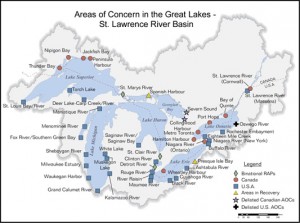
The Dow site and Saginaw Bay is one of 43 Areas of Concern. Click to enarge. Source: USEPA
By Jeff Gillies, gilliesj@msu.edu
Great Lakes Echo
May 28, 2008
Great Lakes advocates hope that this week’s push by the federal government to clean up of one of the nation’s worst sites of dioxin contamination is a sign that the new administration will make good on its promise to jump start restoration of the region.
Environmental Protection Agency administrator Lisa Jackson on Tuesday pledged a strong agency presence in the effort to clean up the Tittabawassee River and Saginaw Bay watershed in Michigan’s Thumb area.
A century of chemical production at Dow Chemical Co. in Midland left sediment in the river system contaminated with dioxin, a likely carcinogen that has been linked to liver damage. Plans for cleaning the area have sparked longtime controversy involving state, local and federal agencies, environmental groups and area residents.
“EPA’s technical and legal resources are assets that can contribute to an effective cleanup, and I am committed to bringing these assets to bear,” Jackson said in a letter to community members affected by the contamination.
This could be good news for other contaminated sites in the Great Lakes basin that have been pegged as Areas of Concern, said Joel Brammeier, vice president for policy with the Alliance for the Great Lakes. Forty-three U.S. and Canadian severely contaminated sites throughout the region are designated as Areas of Concern by the binational International Joint Commission.
Brammeier said the foundation of Great Lakes regional restoration is about getting toxic contaminants out of the water so that they can no longer harm the system.
“That’s what is happening in the Dow cleanup and that’s what going to be happening at contaminated locations along the Great Lakes basin over the next several years,” he said.
Eighteen-Mile Creek in New York is another Area of Concern with dioxin contamination where cleanup has been anemic.
This week’s move also has broad implications for dioxin contamination throughout the Great Lakes and the nation. Jackson also said that the EPA would expedite a long-delayed assessment of the health risks posed by dioxin. The results of the assessment could have a broad impact on the EPA’s role in dioxin cleanup sites, said EPA press officer Brendan Gilfillian.
President Barrack Obama’s proposed federal budget allocates $475 million for Great Lakes restoration, with $176 million going toward cleaning contaminated sediments. But Jackson believes that Dow will fund the Saginaw Bay watershed cleanup.
The Michigan-based environmental groups The Lone Tree Council and Ecology Center cheered Jackson’s announcement.
“The history of this site has been one of regulatory inaction, and aggressive tactics by Dow Chemical to deny and delay, seeding controversy and confusion,” the groups said in a joint release.
Though the Dow cleanup and Great Lakes restoration have seen false starts by the federal government before, Brammeier said he is confident in the new effort, which comes from the Great Lakes Regional Collaboration. That’s a group of federal agencies, Great Lakes state governors, mayors, and tribes that produced a wide-ranging plan in 2005 to clean up the lakes.
“This is the most integrated effort to restore the Great Lakes that there has ever been,” Brammeier said. “That said, we still have to do the hard work of making sure Washington puts the check in the mail to make these plans a reality.”